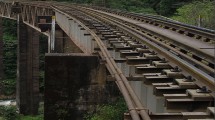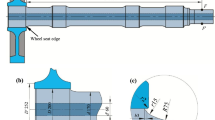Abstract
To assess the residual life of railway truck heavy couplers made of cast steel with initial defects, a testing campaign has been carried out to determine high cycle fatigue strength, fatigue crack growth rate, threshold, and fracture toughness. The numerical model of a damaged No. 17 heavy-haul coupler is established, by fully considering the assembly clearance and the complex nonlinear contact. The fracture mechanics based remaining life under the actual load spectrum is then found. The results show that the remaining life with an initial 4-mm-length surface crack inside the heavy coupler are about 704,300 km and 761,800 km when using the classical Paris law and the advanced NASGRO equation respectively. Based on the advanced NASGRO equation, approximately 12.8% of the life is retained when there is a 20-mm-length crack. The maximum load-carrying capacity of the cast steel couplers shows an exponential downward trend with increases in crack length. The critical size for a non-propagating crack can be assumed to be 20 mm after considering possible high impact loads in service. The predicted mileage is 664,100 km, i.e., the life is about 3.32 years, which is larger than the inspection interval currently used for a railway truck heavy coupler.















Similar content being viewed by others
References
Lima EA, Baruffaldi LB, Manetti JLB et al (2020) Effect of truck shear pads on the dynamic behaviour of heavy haul railway cars. Veh Syst Dyn. https://doi.org/10.1080/00423114.2020.1858120
Dukkipati RV, Narayanaswamy S, Osman MOM (1998) Comparative performance of unconventional railway trucks. Int J Veh Des 19(3):326–339
Ge X, Ling L, Chen SQ et al (2021) Countermeasures for preventing coupler jack-knifing of slave control locomotives in 20,000-tonne heavy-haul trains during cycle braking. Veh Syst Dyn 8:1–22
Guo LR, Wang KY (2018) Analysis of coupler jackknifing and its effect on locomotives on a tangent track. P I Mech Eng. F-J Rai 232(5):1559–1573
Yao Y, Zhang XX, Zhang HJ, Luo SH (2013) The stability mechanism and its application to heavy-haul couplers with arc surface contact. Veh Syst Dyn 51(9):1324–1341
Chang C, Ling L, Chen SQ et al (2021) Dynamic performance evaluation of an inspection wagon for urban railway tracks. Measurement 170:108704
Urda P, Aceituno JF, Munoz S et al (2021) Measurement of railroad track irregularities using an automated recording vehicle. Measurement 183:109765
Bizic M, Petrovic D, Djinovic Z et al (2015) Experimental testing of impact of railway wagons. Exp Techniques 39(3):69–78
Chunduru SP, Kim MJ, Mirman C (2011) Failure analysis of railroad couplers of AAR type E. Eng Fail Anal 18(1):374–385
Dukkipati RV, Swamy SN (2001) Non-linear steady-state curving analysis of some unconventional rail trucks. Mech Mach T Heory 36(4):507–521
Huang J, Xia L, Zhang YS et al (2014) Investigation on brittle fracture mechanism of a grade E cast steel knuckle. Case Stud Eng Fail Anal 2(1):15–24
Infante V, Branco CM, Brito AS et al (2003) A failure analysis study of cast steel railway couplings used for coal transportation. Eng Fail Anal 10(4):475–489
Cernescu A, Dumitru I, Faur N et al (2013) The analysis of a damaged component from the connection system of the wagons. Eng Fail Anal 29:93–107
Boelena R, Curciob P, Cowinc A et al (2004) Ore-car coupler performance at BHP-Billiton Iron Ore. Eng Fail Anal 11(2):221–234
Noughabi S, Dehghani K, Pouranvari M (2007) Failure analysis of automatic coupler SA-3 in railway carriages. Eng Fail Anal 14(5):903–912
Makino T, Sakai H, Kozuka C et al (2020) Overview of fatigue damage evaluation rule for railway axles in Japan and fatigue property of railway axle made of medium carbon steel. Int J Fatigue 132:105361
Wu SC, Zhang SQ, Xu ZW et al (2016) Cyclic plastic strain based damage tolerance for railway axles in China. Int J Fatigue 93:64–70
Regazzi D, Beretta S, Carboni M (2014) An investigation about the influence of deep rolling on fatigue crack growth in railway axles made of a medium strength steel. Eng Fract Mech 131:587–560
Gao Y, Wang P, Wang K et al (2021) Damage tolerance of fractured rails on continuous welded rail track for high-speed railways. Rail Eng Sci 29(1):59–73
Li XH, Xie JL (2006) Prediction of fatigue crack growth condition and lifetime on coupler guard arm area of E grade steel. J Beijing Jiaotong Univ 30(4):102–104
Guo F, Wu SC, Liu JX et al (2021) A time-domain stepwise fatigue assessment to bridge small-scale fracture mechanics with large-scale system dynamics for high-speed maglev lightweight bogies. Eng Fract Mech 248:107711
Wu SC, Xu ZW, Kang GZ et al (2018) Probabilistic fatigue assessment for high-speed railway axles due to foreign object damages. Int J Fatigue 117:90–100
Zhang CC (2014) Test Study on Fatigue Fracture for Forging and Casting Steels of Grade E [Ph.D dissertation]. Dalian: Dalian University of Technology
Hiroshi T, Paris PC, Irwin GR (2000) The Stress Analysis of Cracks Handbook. ASME, New York
Forman RG, Mettu SR (1992) Behavior of surface and corner cracks subjected to tensile and bending loads in Ti-6Al-4V alloy. In: Ernst HA, Saxena A, McDowell DL (eds), Fracture mechanics. 22nd Symposium. Philadelphia: ASTM STP 1131, pp 519 – 46
Newman JC (1984) A crack opening stress equation for fatigue crack growth. Int J Fract Mech 24(4):131–135
Begley JA, Landes JD (1972) Materials 514:1–20
Li CH, Wu SC, Zhang JY et al (2020) Determination of the fatigue P-S-N curves-A critical review and improved backward statistical inference method. Int J Fatigue 139:105789
Hua GR, Wang YC, Li WH (2017) Contact analysis of Type17 coupler based on finite element method. Eng Fail Anal 77:23–30
Wu SC, Liu YX, Li CH et al (2018) On the fatigue performance and residual life of intercity railway axles with inside axle boxes. Eng Fract Mech 197:176–191
Han Q, Wang Y, Yin Y et al (2015) Determination of stress intensity factor for mode I fatigue crack based on finite element analysis. Eng Fract Mech 138:118–126
Wu SC, Liu GR, Cui XY et al (2010) An edge-based smoothed point interpolation method (ES-PIM) for heat transfer analysis of rapid manufacturing system. Int J Heat Mass Tran 53:1938–1950
Chan SK, Tuba IS, Wilson WK (1970) On the finite element method in linear fracture mechanics. Eng Fract Mech 2(1):1–17
Maierhofer J, Pippan R, Gänser HP (2014) Modified NASGRO equation for physically short cracks. Int J Fatigue 59:200–207
Li FS, Wu H, Wu PB (2021) Vibration fatigue dynamic stress simulation under non-stationary state. Mech Syst Signal Pr 146:107006
Ge X, Ling L, Chen Z et al (2021) Experimental assessment of the dynamic performance of slave control locomotive couplers in 20,000-tonne heavy-haul trains. Proc Inst Mech Eng F J Rail Rapid Transit. https://doi.org/10.1177/0954409721993618
Guo F, Wu SC, Liu JX et al (2020) Fatigue life assessment of bogie frames in high-speed railway vehicles considering gear meshing. Int J Fatigue 132:105353
Acknowledgements
Sincere thanks are given to the supports from the Major Systematic Project of China Railway Corporation (P2018J002) and the Open Research Project of State Key Laboratory of Traction Power (2021TPL_T03 and 2019-Q05).
Author information
Authors and Affiliations
Corresponding authors
Additional information
Publisher’s Note
Springer Nature remains neutral with regard to jurisdictional claims in published maps and institutional affiliations.
Rights and permissions
About this article
Cite this article
Ren, X., Wu, S., Xing, H. et al. Fracture mechanics based residual life prediction of railway heavy coupler with measured load spectrum. Int J Fract 234, 313–327 (2022). https://doi.org/10.1007/s10704-022-00627-1
Received:
Accepted:
Published:
Issue Date:
DOI: https://doi.org/10.1007/s10704-022-00627-1




